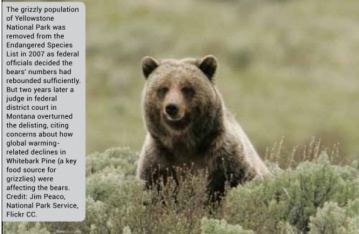
– Jim Meth, Akron, OH
Before
European colonization of North America, upwards of 50,000 grizzly bears -
also known as brown bears - roamed freely across what is now the
continental United States. But more than a century of commercial
trapping, persecution, habitat loss and poorly-regulated hunting have
taken a heavy toll on grizzly populations. Today fewer than 1,500 of the
majestic omnivores are left in just five small pockets of wilderness -
across less than two percent of their former range - on the northern
fringes of Washington state, and scattered throughout the Northern
Rockies around Yellowstone and Glacier national parks. The grizzlies’
threatened status under the U.S.Endangered Species Act has allowed these
remnant populations to start to rebound in recent years, but
conservationists report the fierce bears (their scientific name is Ursus
arctos horribilis) aren’t out of the woods yet, so to speak.
Wildlife biologists consider grizzlies to be an “umbrella” species, meaning that the health of their populations indicates how healthy hundreds of other native plant and animal species may be across the same habitat range. Grizzlies thrive in large uninterrupted wilderness areas, so environmental groups are working hard to connect up existing protected areas, to allow the bears to move into new territory and continue to rebound. “Protecting the habitats that allow the bear the freedom to roam and thrive also benefits mule deer, wolverines, elk and mountain goats, and many more wildlife,” reports Conservation Northwest, a regional environmental group championing efforts to expand wilderness designations and so-called “wildlife corridors” - protected habitat pathways between larger swaths of wilderness - in Northwest Washington State for the sake of grizzlies and other wildlife down the forest food chain. “Protecting the roadless watersheds that nurture the grizzly bear helps ensure clean water, solitude and recreational opportunities for everyone.”
Another leading conservation organization working to secure a better future for grizzlies in the lower 48 is Defenders of Wildlife. The group supports and promotes projects to help reduce human-grizzly conflicts and increase community tolerance for having the bears as neighbors. One such program involves assisting homeowners with funding for the installation of bear-resistant electric fencing, which has proven to be a safe and accepted way to deter bears from accessing human food resources.
Defenders reasons that training the bears not to access human food gives them a better chance for survival, as they cannot become dependent on a resource bound to get them in trouble. Yet another big advocate for grizzlies is the National Wildfire Federation (NWF). The group’s Adopt-a-Wildfire- Acre program uses funds raised from members and other concerned donors to acquire land outside of Yellowstone National Park to give the region’s iconic grizzly population room to roam beyond the confines of the park borders. NWF also works the halls of Congress, lobbying on behalf of grizzlies and other iconic American wildlife species suffering at the hands of progress. Environmentalists are optimistic that better planning and more focus on conservation will allow the grizzly population of the Lower 48 to continue rebounding to the point where the bears can be removed from threatened species protection. As Conservation Northwest puts it, “What’s good for bears is good for people”.
CONTACTS : Conservation Northwest, www.conservationnw.org; Defenders of Wildlife, www.defenders.org; NWF, www.nwf.org.
EarthTalk® is written and edited by Roddy Scheer and Doug Moss and is a registered trademark of E - The Environmental Magazine (www.emagazine.com). Send questions to: earthtalk@emagazine.com.
























